My son’s kindergarten class took a field trip to pick apples at an orchard in Julian a couple weeks ago. My wife asked his teacher if he could go but not pick apples. Can he go on the field trip to the apple orchard but not pick apples?
Every so often we notice how strange we are.
You see, his father here has worked hard to plant a number of diverse fruit trees such that his son has something fresh to pick every day of the year. And in fact, right now there are plenty of apples ripe on the trees in the yard.
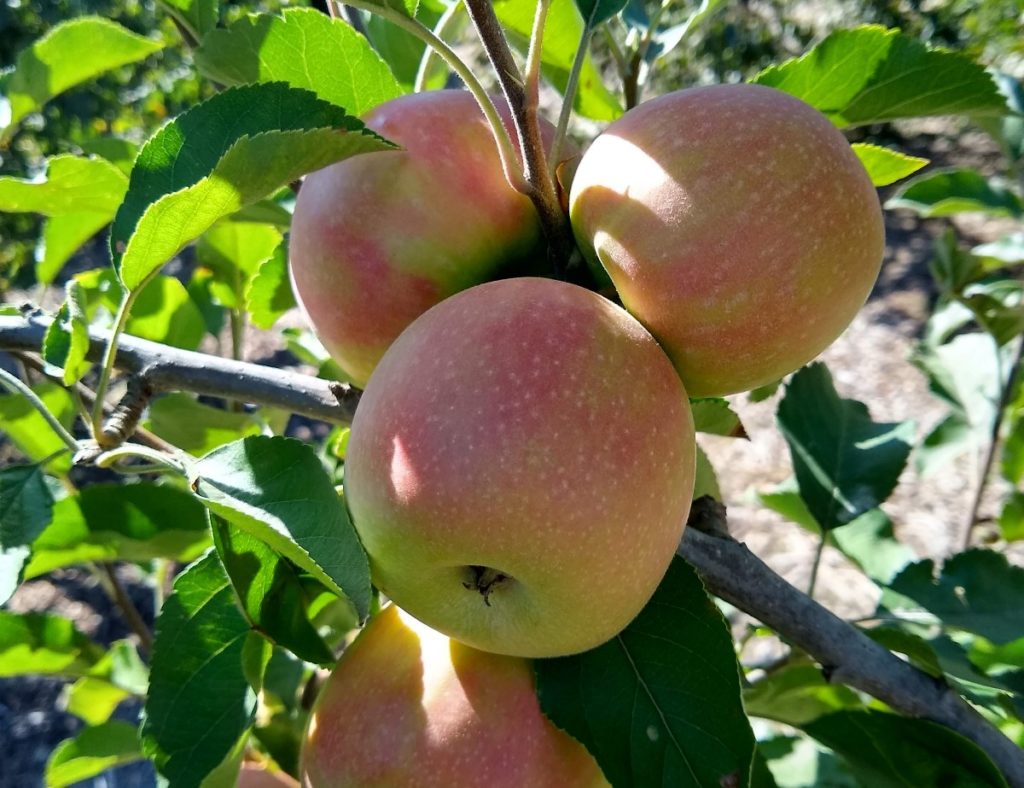
Providing fresh fruit all year for my family was my dream when we bought our house six years ago. It is only this year that for the first time we have a truly full, year-round harvest.
This post is about which trees I planted, how I chose my trees, what mistakes I’ve made, and how one might accomplish this in slightly different contexts.
Should I answer the question as to why one would want to do this in the first place? Okay, a few top reasons: better taste, cleaner and healthier for all (no poison sprays of any kind), and convenient.
General seasons of types of fruit trees
In order to have fresh fruit to pick off trees in your yard every day of the year you need two things: trees with different harvest windows, and enough of them.
Each type of fruit tree has a main harvest season. For example, peaches are mainly harvested in the middle of summer. There are some early and late varieties of peaches, but most varieties are ripe about the middle of summer. It’s useful to know these main harvest seasons when choosing trees to cover the year.
A crude summary of the main harvest seasons of different types of fruit trees is as follows: Winter through spring is covered by citrus (mandarins and oranges). Summer is for stone fruits (first apricots, then peaches and nectarines, then plums and pluots). Late summer and fall is apples and pears, and then persimmons and pomegranates too.
When I was choosing fruit trees for my yard, I had these main harvest seasons in mind, but then for specific varieties I referred to charts such as this one from Dave Wilson Nursery for deciduous fruit trees and this one from Maddock Nursery for citrus varieties. The Sunset Western Garden Book is also a good reference here.
Which trees did I choose for a year-round harvest?
Here is a chart I drew of the main dozen fruit trees that I chose and the harvest seasons of each:
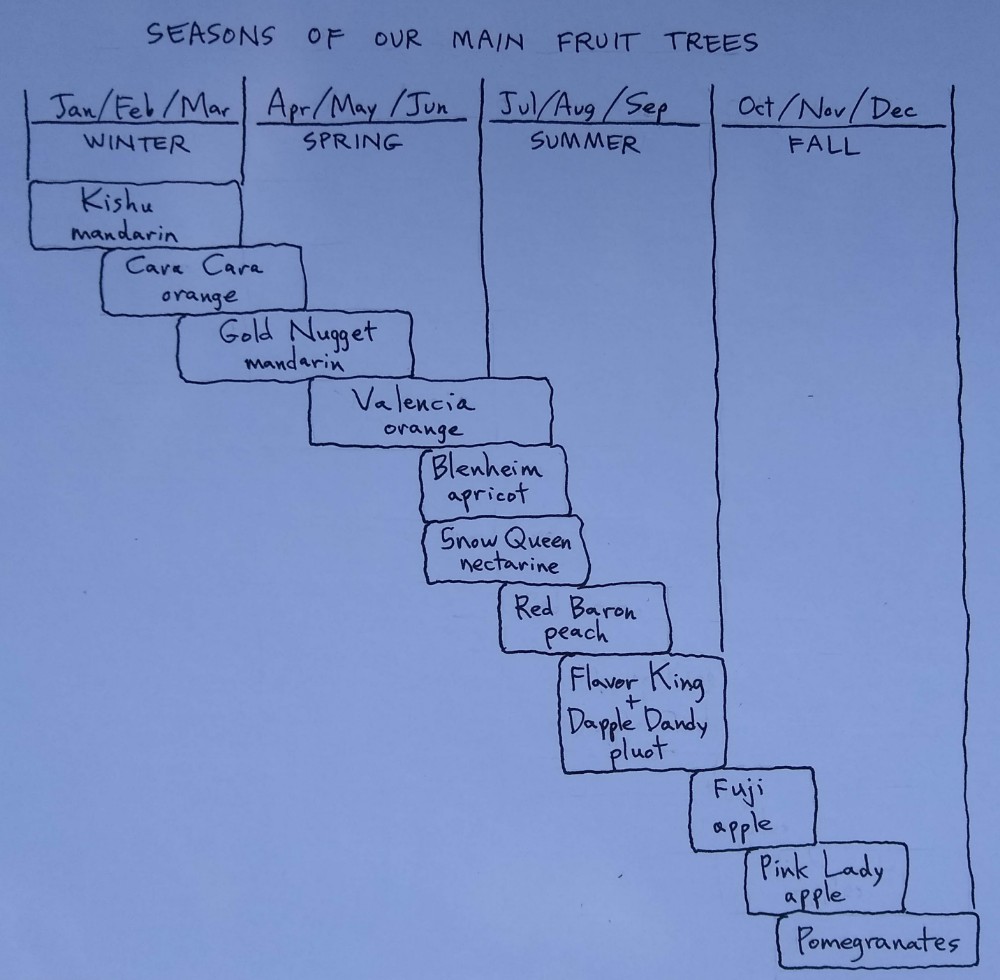
Winter and spring are covered by the citrus varieties of Kishu and Gold Nugget mandarins, and Cara Cara and Valencia oranges. Summer is Blenheim apricots, then Snow Queen nectarines, then Red Baron peaches. Next come the Flavor King and Dapple Dandy pluots. In the fall are Fuji and Pink Lady apples, and then pomegranates.
The truth is that we also have some vines and berries that fill in here and there throughout the year, as well as a few other fruit trees, but the varieties on this chart show our core trees which we all love and which alone could cover the whole year.
How to choose your trees?
There are a hundred other types of fruit trees you can grow in Southern California: jujube, mango, banana, feijoa, guava, fig, and on and on. I chose ours based on what we already liked to eat, what would grow well in our yard’s climate (as far as I could tell), and what we couldn’t buy of high quality elsewhere.
For example, we don’t grow many bananas because they don’t like our chilly winters very much and we can buy decent bananas at the grocery store.
(For more on choosing fruit trees, see my post “What kind of fruit tree should you plant?”)
How many trees do you need?
Our core is a dozen trees, but there are a lot of factors that might make your needs different.
The main one, however, is how many people you are feeding. We are a family of five.
If you are just two or three people, you could get away with fewer trees but I would guess that you would still need close to a dozen varieties. You still need to cover the year; you just don’t want as much fruit at any one time. How can you accomplish that?
Multi-graft trees are one great option here. In fact, our Snow Queen nectarines and Red Baron peaches are on one tree.
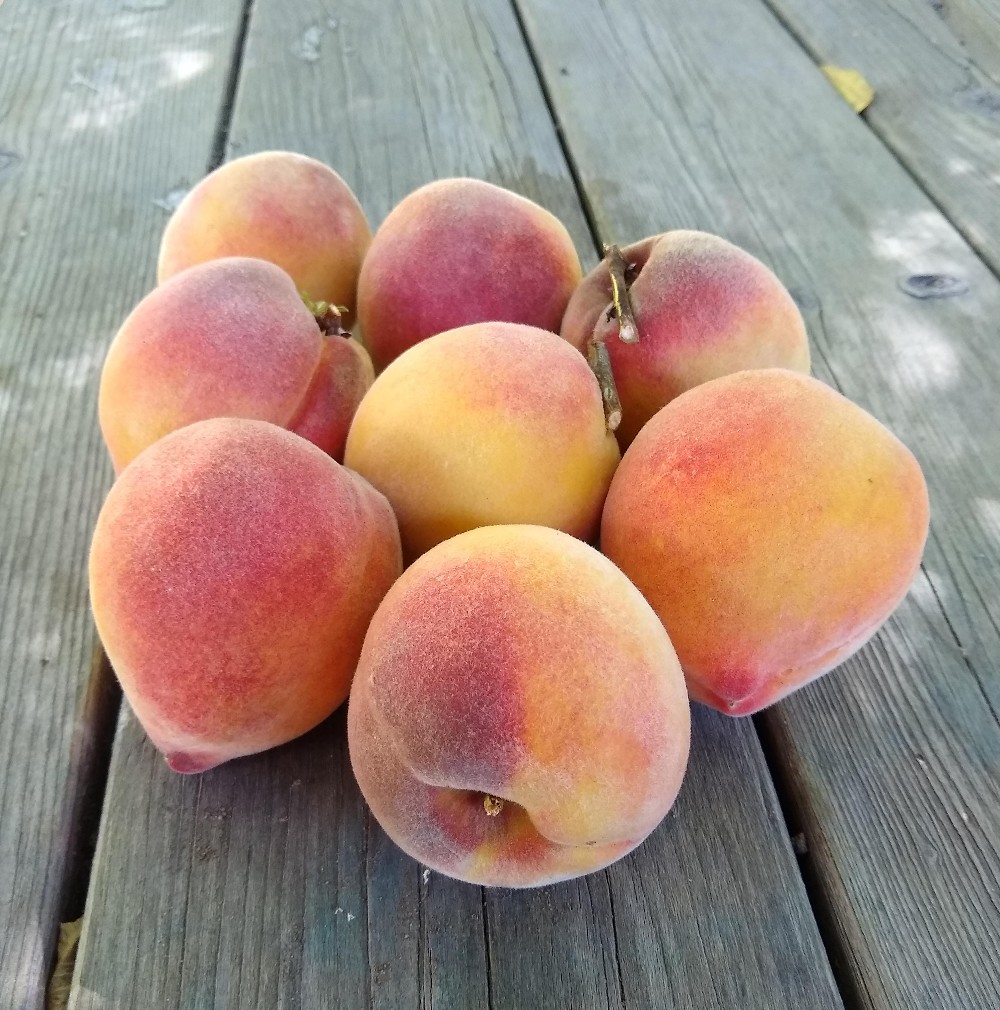
The tree is about two-thirds nectarine branches and one-third peach branches. I did the grafting myself, but you can buy similar trees.
It is a small tree — I keep it pruned to only the height of my reach — and yet it still makes more fruit than our family of five can consume in some years. For only two or three people, it seems clear that a single large and productive peach tree would provide far too much fruit in a short period of time for fresh eating.

So try multi-graft trees or try planting individual trees close together. You can fit a dozen fruit trees into a surprisingly small area this way, and by doing so you’ll essentially get the production of a half a tree out of each one.
(For reference, my deciduous fruit trees are mostly planted 14 feet apart, and my citrus trees are about ten feet apart.)
In the winter of 2011-2012, I planted seven fruit trees in a row along a wall in my mom’s backyard. I spaced the trees eight feet apart, like a fruit-tree hedge. Here is how they looked after losing their leaves in their fifth winter:

One of my aunts has seven fruit trees which she keeps pruned down in her suburban backyard. From them she gets fresh fruit almost all year. Also in her backyard is a vegetable garden, a lawn, a swingset, and a patio with tables.
The other day, I visited a friend who has eleven fruit trees in his small suburban backyard. He carefully chose a combination of deciduous and citrus trees that will give him a successive harvest all year. But in addition to his trees, he has a patch of grass and a shaded patio with a picnic table.
The point is that even in a surprisingly small backyard you can have your fruit trees and space for other things.
(See my post, “My best advice on pruning deciduous fruit trees: Keep them small.”)
How many years until reaching a year-round harvest?
I’ve found that most fruit trees take approximately three years before giving a substantial harvest. For example, I planted our Gold Nugget mandarin from a five-gallon container in 2015, and we ate dozens of mandarins from it in the spring of 2018.
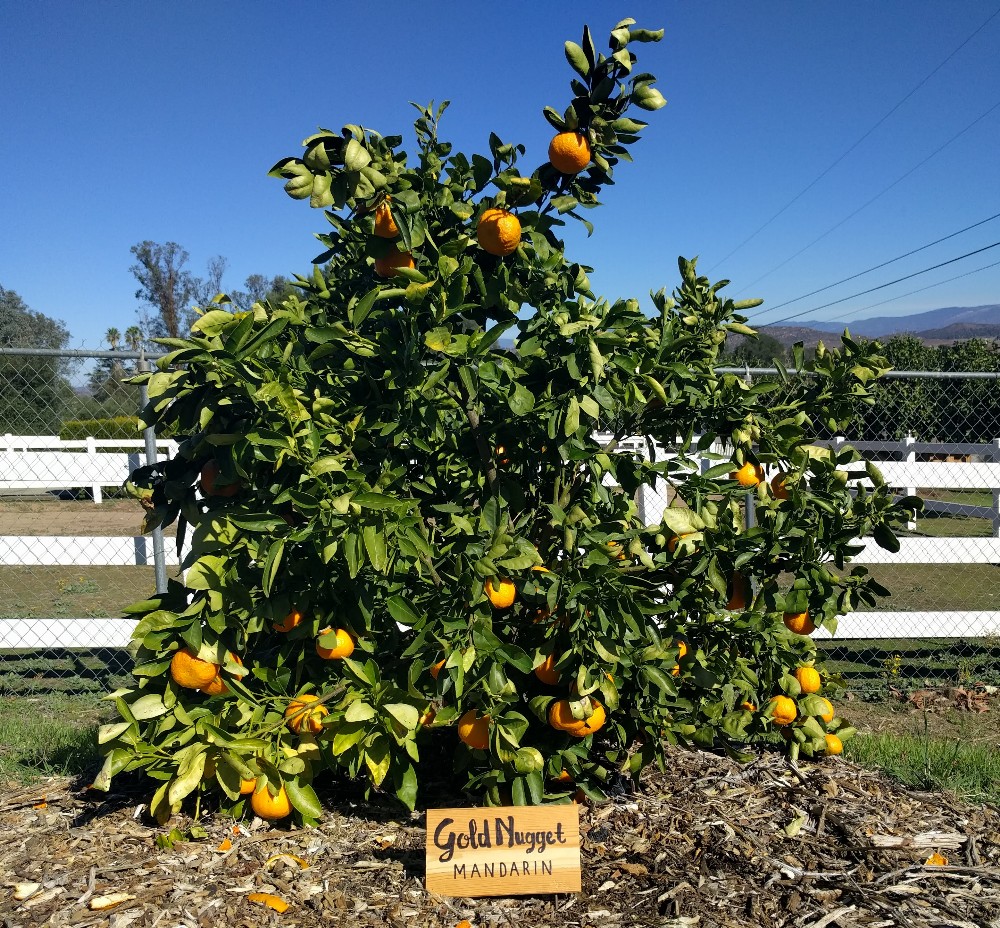
I planted our Flavor King pluot as a bare-root tree in January of 2017. It gave us a couple pluots last summer, but gave us an abundance this summer of 2019.
I planted our Pink Lady apple as a bare-root tree in February of 2015. It gave us about twenty apples last year, but here in 2019 I had to thin a lot of its fruit and it’s able to hold about 50 apples to maturity.
So I’ll say that it takes most fruit trees two to four years before a substantial harvest — three years on average.
Unexpected hiccups along the way?
There is always an element of discovery involved with this kind of endeavor, however. A particular fruit tree might not be as suitable to the climate in your yard as you’d guessed. Or a particular tree’s fruit might not be as suited to your tastes as you’d guessed.
When I started planting fruit trees we didn’t have kids so I had no way of knowing which fruit they’d prefer. It ends up that they are all crazy for apples and pears. I’ve planted more apples and pears recently.
In contrast, I guessed that the kids would like figs. It turns out that even though they love fig newtons, they don’t like figs much. I removed the fig trees.
As an aside, Flavor King pluots are probably the kids’ favorite overall during summer.
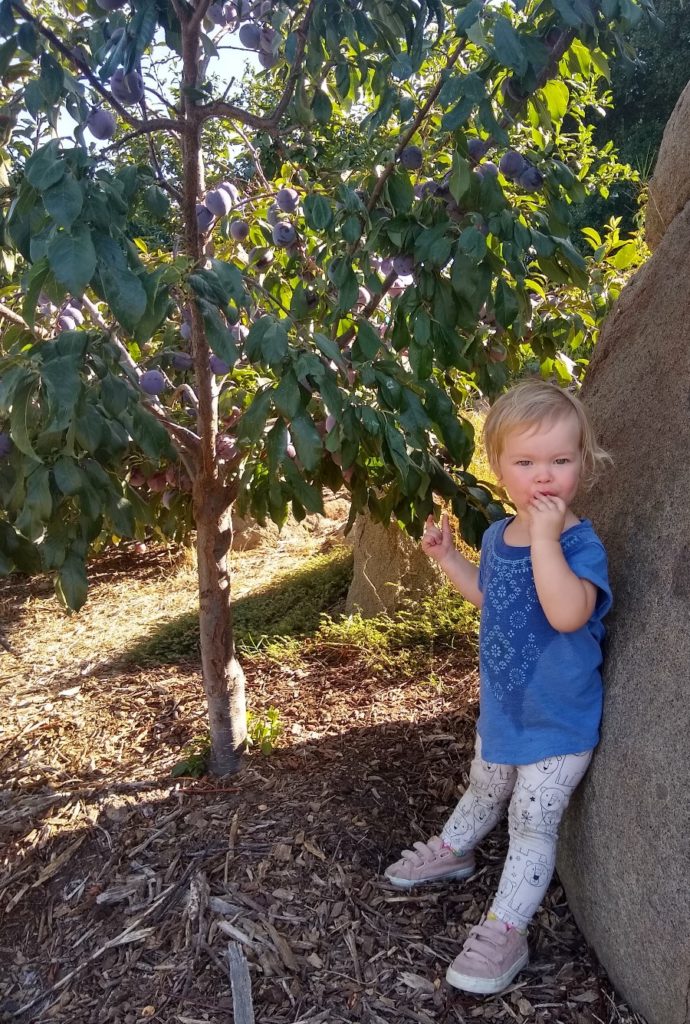
And during winter, Kishu mandarins are their favorite.
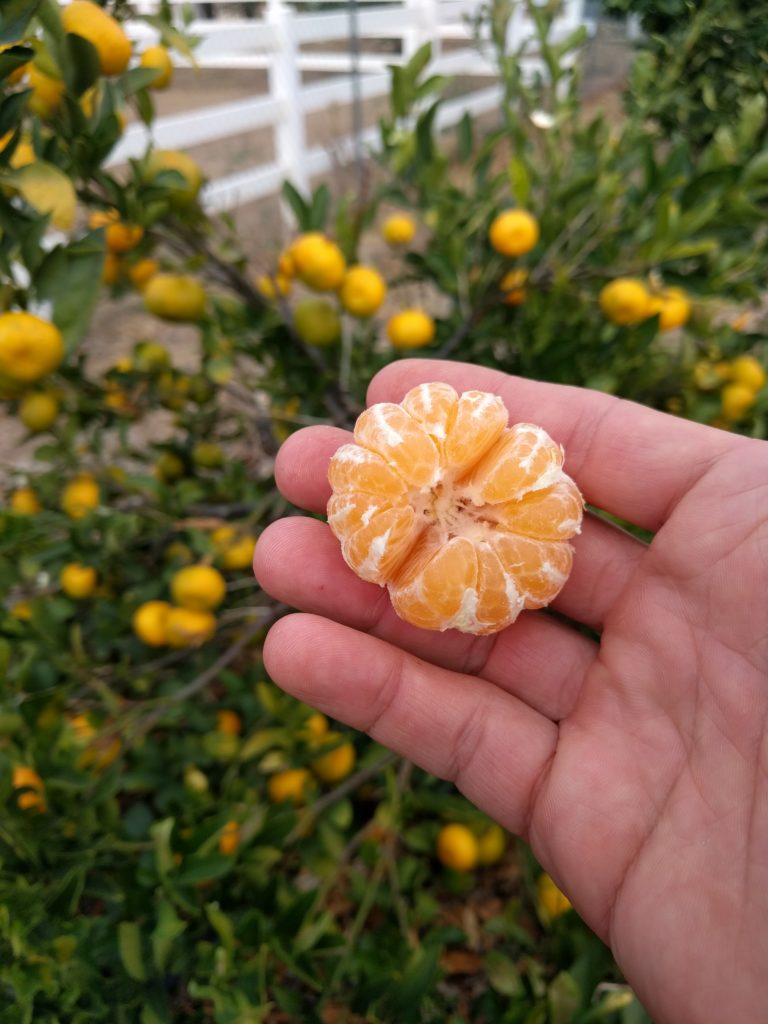
Maybe your kids or grandkids will like these varieties too. (See my posts on growing pluots and Kishu mandarins.)
Is the year-round harvest as cool as I imagined?
Long ago, I dreamed of having a yard in which I could wander and snack. Then I began to dream of a yard where my whole family could wander and snack. We finally have it. Is it all I hoped it would be?
It’s not all that our kids hoped for. They have no idea that every yard isn’t a place where you can pick fruit off trees any time your belly beckons. It’s not exciting to them at all. They’re not ungrateful; they just don’t know any different.
But once this summer some neighbor kids visited and they followed our kids around to pick what our kids picked. It was early in the summer so there were still lots of berries to be harvested too. After a half hour of moving from patch to patch and tree to tree, one girl looked up and said, “It’s like a food forest!”
You might also like to read my posts:
Growing fruit trees in Southern California




Thanks for sharing your knowledge again! I will prune my peach next week!! I just harvested some pomegranates today… And I’ve loved my small but tastey apples!
Hi Aunt Syndea,
We’ve loved our Fuji apples too — so much that we ate the last ones yesterday, just when they started tasting really good. I don’t know about you, but I actually prefer them small. I can’t eat a whole giant apple at one time.
I live in Santa Barbara coast zone 10 can I grow pink Lady apples in my zone?
Hi David,
Yes, Pink Lady apple trees can produce well in a climate like Santa Barbara. I have seen Pink Lady apple trees producing well in the Point Loma neighborhood of San Diego, for example.
Greg, your website is amazing. Your writting and advice is outstanding. I expect your website to become the number 1 referencing fruit trees, probably in the world!
I’m sure you also have avocados all year also. I have have 15 avocado trees and have 3 Reed fruit left to pick. Most of my trees are small and many of my trees do not do well due to too much shade, so other people might need more trees for the same issue. Fuerte and my Cadway Cado will be putting out late November and then the cycle starts again. I would like to suggest to you and your readers some varieties that are excellent. Gold Nugget is at the top along with Tahoe Gold, but they ripen in Feb-March. If you plant a Satsuma (Miho Wase is best) then you will have mandarins in Dec too . I love Washington Navel and Cara Cara. My Moro blood orange is just good, but my Taracco Blood orange has become my favorite. I’ve got the longest growing season for peaches using May pride, June pride, Early Elberta (favorite), August pride, and Caravel, the latest. I was not crazy about figs until I planted a Janice seedless – they get really big and sweet and almost no seeds, so you don’t get that crunch in every bite. You should really plant a cotton candy Aprium – excellent. My Pluots bloom in the fall and barely produce anything in the next summer. I’m in 92120 and I have blooms on my pluots right now in Oct. so I know the buds will be gone soon. Eversweet is the best pomegranate, White is the best Cherimoya, Oro Blanco grapefruit is really good. Fuji Apples are self pollinating and rock hard off the tree. If you want to do some grafting I suggest you get Shiranui bud wood. You can’t buy the trees. I’ve been struggling to get good growing Shiranui trees, but the small number I’ve grown are excellent. It goes by the trade name “sumo”.
I hope your readers enjoy my suggestions and I like sharing on your website since lots more people will be coming here in the future.
Thank you, Richard. Awesome contributions as always! We all benefit from them.
When writing these posts I’m always trying to be brief enough to be readable, yet detailed enough to be useful. Then I hope that kind and experienced folks like you will add information and nuance in the comments section just like you did.
By the way, I second your kudos for Tarocco blood orange. Less bloody than Moro but better taste.
Richard, I love your contributions!! I will keep in mind your recommendation for when I choose scions in January! Thanks so much! Jean
As usual another great post for the home orchard! I love the DW Nursery chart you’ve shared. As a newbie in planting and planning an orchard I’ve gained so much guidance from you! Thanks for sharing your knowledge and experience… it’s so appreciated!
We are planing on planting avacado , great location in VC just not sure how well certain varieties will do with the salinity in the city water. We are surrounded by orange and avos most all irrigated with well water and all thriving rather well. Also want to maintain a low canopy for easy harvesting, any issues regarding topping for this purpose ?
Enjoy reading the Yard Post
Hi Greg,
VC is Valley Center, right? The quality of your district water is probably about the same as mine in Ramona, which is not great for avocados but acceptable. That goes for any variety although you’ll find that some varieties tolerate it better.
I wouldn’t focus on salt tolerance when choosing which varieties to plant, but you could get your trees on rootstocks that have greater salt tolerance. (A few of my trees are on such rootstocks but most of them aren’t.) Subtropica Nursery in Fallbrook can provide those: https://www.subtropicanurseries.com/
It’s pretty easy to keep avocado trees smaller than they would grow naturally. See this post about that: https://gregalder.com/yardposts/can-you-grow-an-avocado-tree-in-a-small-yard-space/
Best of luck!
Greg, just stumbled across your posts last week. I had 19 trees 5-7 years old planted March 15, 2019. So I have browsed many Youtube sites and videos but none come close to yours. I have 7 avocado trees-3 Sir Prize, 2 Haas and 2 Fuerte. The Sir Prize have 8 fruits total, the Fuerte 3 and the Hass 1. They all came with many buds but pollination I guess was very low. I deep water once a week with drip bubblers, about 12 gallons each time. My tensiometer[?] probe always reads “moist”. BTW , I called the chip supplier you recommended {Evergreen]but they would only do truck loads. So I applied Kellogg 2 in 1 Organic Mulch. Hope that will work. All avocado leaves are deep green with tip burn well below the 20% you noted in one of your posts. Sorry for this long email but when i last gardened, 20 years ago, it was all annuals and I didn’t need to know anything. My home then in Whittier grew anything [except watermelons!] . Just plant and pick!. So my query is what should I change or do to get more pollination next year. Any advice will be sincerely appreciated!
Hi John,
It sounds like things are going pretty well with your trees considering they have been in the ground less than a year.
Watering is key for avocados, especially young ones, and especially if you live more than a couple miles from the beach. It sounds like you’re doing that part right. Judge the tip burn on the foliage in about January. That’s when it’s at its worst.
For pollination, avocados need flying insects, mostly bees. It has seemed to help in my yard to have specific flowering plants around to feed the bees and keep their numbers high. Some growers even keep their own honey bee hives near their avocado trees, which definitely helps.
Thanks Greg for your tips. Do you consult on site? I need your experience to look at each one of my 19 trees in Norco and render judgement!
John Brown
Thanks for another great post. So interesting and informative. Congrats on achieving your goal of a year round fruit harvest!
Do you run into issues with alternate bearing trees? What do you do to combat that? I’ve read about a few strategies but wondering what works best for you. Fruit trees are new to me and I have bought a few tangerine trees and read that one of the cultivars I purchased (Dancy) is prone to it, wanting to avoid it if I can.
Hi Patricia,
Thanks! A few of my fruit trees have shown a tendency to alternate bear, but I haven’t done much about it. Really, the only thing I’ve done is double up on varieties for each harvest window. That’s an easy option for me because I have the space.
My grandma has an old Dancy tangerine and it has definitely had on and off years. My Gold Nugget mandarin had a very light crop this year but is holding a heavy crop to be eaten next spring. I have read of a couple of strategies for mitigating this alternate bearing. One is pruning. My Gold Nugget isn’t quite big enough to need pruning, but I’ll test that out in the next couple years.
It is also said that not allowing the fruit to hang too long past maturity will help reduce alternate bearing. But again, I haven’t tested this on my own trees.
I do have an old Valencia orange tree that alternates a bit, but I haven’t seen any correlation with how much I prune it or when we harvest the fruit.
With deciduous fruit trees in my own yard, the size of the crop each year has been most closely related to the weather. Cold winters like last winter result in lots of fruit; warm winters like the previous one result in less fruit — especially for some varieties. I prune them and thin them and harvest them all the same every year. Not much you can do about the weather. But at least if you’ve got varieties that are suited to the climate in your yard most years, then there should be fairly consistent yields.
Another great post Greg!! Really helpful to
Have the perspective of the number of total Trees and the varieties needed to have fruits all Year round. I’m
Trying to achieve the same as you. I have a large hillside (a bit steep and slippery for walking). I’d like to make use of that hand more but want to put trees there that don’t require Constant monitoring and maintenance. Any suggestions?
Thanks, Jean! Some fruit trees that require less monitoring and maintenance — if you’re not trying to shape them or keep them to a specific size — include pomegranates, persimmons, figs (except for their susceptibility to gophers), loquats, and all citrus. I could see growing these on a hillside and losing some fruit to birds and critters but still having plenty for yourself. This might depend on which critters you have around though.
Great post, as always. But I don’t understand why your wife didn’t want you son to pick apples on his field trip. Seems to me he would be able to show the other kids how to find the good ones, and he’s certainly in the habit of grazing.
Hi Keith,
Right! It was that he was supposed to pay to pick a bag of apples. All ended well: he bought and picked the apples, and he shared with his brother and sister, and they enjoyed eating some different varieties.
It was also curious to me that the majority of the apples from this orchard had coddling moth worm holes. Our apples have no coddling moths yet, and I’m wondering if it’s because I let our chickens scratch below the trees regularly. Maybe they unearth and eat the larvae.
My money’s on the chickens. We have way fewer of them after the chickens ran free in the yard. Lots of flies, though.
Great post. Back in 2012 I began planting with the goal of year round fruit. Stone fruits are definitely my strong suit as we pull them off the trees starting in late April and go into early October, and have some of just about everything. Citrus has been more of a challenge but is starting to work out (I’ve noticed that citrus trees take their own sweet time to grow). Our mature stuff is loaded but the more recently planted trees are still mostly growing vs fruiting. As one would expect, we’re loaded with lemons and couldn’t kill one of those trees if we tried. I’m actually a fan of the Moro blood orange in large part because of the sweetness and the intense red if left on the tree until it’s absolutely ready. Cutting into one of those is reminiscent of Al Capone giving the team player speech in The Untouchables. A horrible example but you get the point.
My avocados have been my biggest challenge, along with persimmons. I’m going to have to move one persimmon and get two more bare roots this year to make up for my losses there. Two more avocados (Pinkerton and Stewart) are going into the ground tomorrow on a big pile of dg in a raised bed I created, and I remain optimistic that this time I didn’t just create a giant avocado sarcophagus. My Sir Prize is barely on par with a Charlie Brown Christmas tree but my Lamb Hass and Edranol are, by my standards, finally doing well, small but well.
As for the weird stuff, our cherimoya is finally producing but there’s only a few fruit on it and I don’t see anything on the atemoya yet. The star fruit is pretty spindly but may actually be about to set flowers so who knows what’ll come in next year. The mango is producing quite nicely (my advice is to get small fruit mangos as the large ones don’t ripen enough before winter). The bananas are coming along really well for the first time in years. We had more passion fruit than I knew what to do with so the chickens were eating pretty well for a while. The papaya is loaded but last year they were basically added to the compost pile, again for our entitled spoiled little chickens. I’m hopeful there will be plenty this year before it gets too cold. The lemon guava is loaded but the rats attack it as it’s the only ripe fruit on my trees this time of year. My fijoa is producing fruit for the first time ever but I think it’s late by most metrics and may still have a month or so to go on the tree. It’s pretty well shaded so I’m certain that stunts it. The sapote is also producing for the first time ever, albeit only two fruit. One of the strangest things we planted is a Kona coffee. It fruits but the cherries were very small this year as compared to last year. No fruit yet on a three year old ice cream bean but it’s growing really well considering it’s almost totally shaded. I have lots of pineapple tops in the ground but they don’t do much but look like a bunch of pineapple tops in the ground.
We had gobs of grapes this year but the green bugs did a number on them, although there was enough of the zinfandel to make a gallon and a half of wine. I won’t really know how that worked out for some time, though.
Some of the Asian stuff is starting to ripen but not in large quantities. I only got a couple of Chinese dates off the one tree but the longans are doing really well. The jambu is small with no fruit yet, healthy but small. A 20th century pear my wife and I planted years ago only makes a few pears each season and they aren’t very big. Our other pomes are a pink lady and a 4 in 1 from Dave Wilson. We get apples but only a few and the trees don’t seem to grow very quickly at all.
Berries have always been a challenge and I think I’m going to remove our blackberry due to no flowers and fruit (any advice there would be greatly appreciated). I started a weeping mulberry in that area in anticipation of pulling out the blackberries. I planted golden raspberries here and there and they may actually take off next year. I need to move our boysenberry into the sun as it think it’ll do better there. Nothing to report on our blueberries yet except that one died; hopefully we’ll get some next year.
Figs, lots of figs. Those trees grow like weeds.
For anyone interested, as best I can tell from the maps, I’m at the very western side of 10a and somewhat surrounded on three sides by 10b, a mile south of SDSU. Most of what we grow is on a north facing hillside which I’m sure has slowed the growth. everything is pretty densely planted, too. The fancy tropical stuff is on the southern edge of the property against the house and gets plenty of sun, heat, and reflected light up there.
As you mentioned, you like to keep it brief, which I’m sure is all the more appreciated by your readers after making this far in my anything but concise comment. That being said, thank you for all your insightful posts.
Thanks for all of this, Bob!
Is there anything you don’t have?!
Any ideas on what you’re doing differently for your avocados now to make them happier?
Is your mango a Manila seedling from La Verne Nursery, by chance?
Do you prune those blackberries? How long have the canes been growing?
Avocados: fertilizer, compost and mulch, checking the moisture more often, shade when super sunny/hot, little fences to keep the chickens from digging up the mulch, some major trimming of the shade producing bushes to allow more light in, and lots of wishful thinking.
Mango: I can only answer this because I’m a nerd about keeping records. Yes, Manilla (good guess) from Lowes but originated at La Verne, planted in October of 2015
Berries: Unknown variety planted back in 2013 and pretty much left to grow with some trimming here and there. I don’t prune them but did once and it didn’t seem to do much. Are you suggesting prune them and see what happens? How should I prune them?
There are a quite a few more plants over here I didn’t mention but I’ve pretty much taken advantage of anyplace that will take a plant and put one there, whether it be hedges, bushes, stand alone trees, etc. Multi grafts, two and three in one hole, dense planting, large pots, etc. My philosophy is that if I have to water it I may as well be able to eat it. When I have parties here my friends often times ask me to walk them through all of the plants and it takes a good 45 minutes and at least one refill of the wine cup. We’re on a third of an acre (all usable), which is pretty rare in the middle of the city.
Thank you.
Hi Bob,
Wow, you’ve got a gem of a property. I love those places that have so much usable land within the city. Every time I think I’m running out of space in my yard I recall how much I had packed into my previous, tiny yard near Balboa Park.
Funny you mention little fences because I too have been adding more of those around my young avocado trees on the hill so the chickens don’t scratch every bit of mulch away — and expose all surface roots.
So strange about your blackberries. I’d try planting a new variety. I can’t imagine what the problem is because in my experience they’ll produce at least some even in full shade and less than optimal water. I was thinking you might have been pruning too much, but that’s obviously not the case. I’ll root the tips of some of my boysenberries this winter and try to get one of those plants for you to try.
Some blackberry shoots would be great. I think you might have some boysenberry as well. Also, anything here you want to pick from and graft is fine by me. Some of the larger mangos are falling off now but haven’t turned totally yellow yet. I’ll cut one tomorrow and see how it is. Lately I’ve been cutting the bottoms off one gallon pots and slicing them so I can put them at the trunks. The very same chickens that scratch the mulch/compost away also push it against the trunks. Not a problem in the summer but I lost a tree last winter and I’m certain was due to too much moisture at the base of the tree rotting the bark away. Send me an email if you wish to coordinate the blackberry etc swap and I’ll also send you a full list of what I’ve got here. My plants range anywhere from 1 year to 10 plus years. I’m not getting emails as notifications of comments.
Wonderful info….thank you!
Am i barking up the wrong tree. I have an apple fruiting mulberry, cherry not fruiting, goji berry, blueberry, 2 mandarins, thorn less blackberry my dragon fruit cactus died banana and fig.I would like to get some exotics like Star Fruit Lychee and others of that sort. Can I put them in between evergreen trees to help keep the exotics warm. I will take the advice as to multiples on the same tree.
Hi Dorothy,
I don’t think that putting the cold-sensitive trees in between evergreen trees will keep them warm, unless they are actually under the trees’ canopies. That has always been my experience.
Hey Greg,
We’re new to San Diego and trying to figure out what the best non-deciduous/evergreen fruit trees will be to plant in our yard. We want evergreen options for the year-round coverage & privacy. I’m thinking some type of Mandarin because we definitely want to eat what we grow. Currently, we have Meyer Lemons & Fig. Our home is in The La Costa area of Carlsbad, so we’re up from the ocean abit.
Thanks for any insights & advice you can lend!
Thanks & Cheers,
Darren
Hi Darren,
In La Costa you can grow almost every type of evergreen fruit tree you can imagine, save truly tropical trees like cashew. To get a taste of the options, you might try visiting the orchard at Miracosta College in nearby Oceanside. There you’ll find everything from bananas to coffee to avocados to mangos and much more. This list isn’t up to date, but it gives you an idea of what they have: https://www.miracosta.edu/instruction/horticulture/downloads/Orchard_tree_inventoryforpublic_000.pdf
You might also visit the San Diego Botanic Garden in Encinitas, as they have lots of evergreen fruit trees that would also do great in your yard: https://sdbgarden.org/
As for mandarins, that’s an excellent option for your area and needs. There are so many good varieties you can choose from. Here are a couple of posts I’ve written that might help you choose a mandarin variety:
https://gregalder.com/yardposts/the-gold-nugget-mandarin-tree-a-profile/
https://gregalder.com/yardposts/the-best-fruit-tree-for-kids-and-the-winner-is-kishu/
https://gregalder.com/yardposts/oranges-and-mandarins-fresh-off-the-tree-almost-all-year/
Just curious if anyone else is picking pomegranates already. I’ve picked a dozen or so, most of which I found under the tree and fallen off when I recently propped up a bunch of heavily loaded branches. My bush is so loaded its crazy. I have been eating them for a week or more, and continue to find ones that are already cracked. I picked one that was not cracked, but just looked and felt ready, and it was delicious!
Unfortunately I no longer have the tag that identifies the variety, but I think its called Wonderful. its very bushlike. Most other years we haven’t gotten good fruit until late October. Not sure if its the late rains, the Labor day heat, or ??
Forgot to mention I am in Santa Barbara
Hi Matt,
I have been picking pomegranates from one of my trees, but it is not earlier than usual. It’s an early variety called Utah Sweet. My later tree, of an unknown variety, isn’t ready yet. It’s like yours in that it’s usually not good until Halloween. I think most of Southern California has had a hotter than normal late summer. Maybe that’s a factor for you. But I can’t say I notice anything coming in early right now in my yard.
blenders card in pannier
thanks for the feedback Greg. Regardless of the reasons, we’re glad to have an extra month and a half to eat the bounty of persimmons we have this year. We’ll certainly be giving some away as well.
Hello, My question is do you know if a pluot tree would grow in Riverside county? We live in Moreno valley.
Hi Geraldine,
Most definitely, yes. I know pluots doing well near you in Riverside. Be sure to plant the right combination of pluot/plum trees. For help on that, see my post on pluots here: https://gregalder.com/yardposts/growing-pluots-in-southern-california/
Surprise you didnt use lemons or limes. I guess theyre not for eating off the tree so much, but i got some to make awesome lemon/lime curd and also lemon/limeade. I am making a year round fruit garden in case we ever get to a point we need to trade with neighbors and friends for necessities ( since pandemic it got me thinking) and we have early blooming strawberries (they actually start in march), honeyberries, raspberries, blackberries, limes, (not year a year round plant but we plant watermelon each year), pomegranates, apples, lemons, and 2 types of oranges since citrus grows so well in our area. I loved seeing what u plant. This was a nice article!
Love your website Greg. I’ve planted a GEM and Reed based on your guidance.
My family and I live about 2 miles from the beach in Carlsbad. I wanna make sure that I get the right trees for year round fruit.
Being that we’re on the coast, is there a rule of thumb as too when fruit is ready for harvesting? Should I look at your charts and push back a month or two?
Many thanks.
Pete
Love your posts Greg!
I have a suburban garden in Irvine consisting of 3 cherimoya, 4 stone fruit,1 longan, 1 avocado and 1/3 fruit bearing kishu. The stone fruits don’t bear much and when they do, our neighborhood squirrels get about 90% of the crop. Any suggestions on other fruit trees that the squirrels might not enjoy?
Hi Tanya,
At my place we have ground squirrels (no tree squirrels), and they have never gone after my pomegranates although I don’t know if they would if nothing else were available. They also are not as attracted to citrus as other fruits.
I found this article to be very useful and I have more specific questions with planting year round, organic, which varieities, etc. Is there a way to possibly email or contact you directly for some suggestions? Thanks